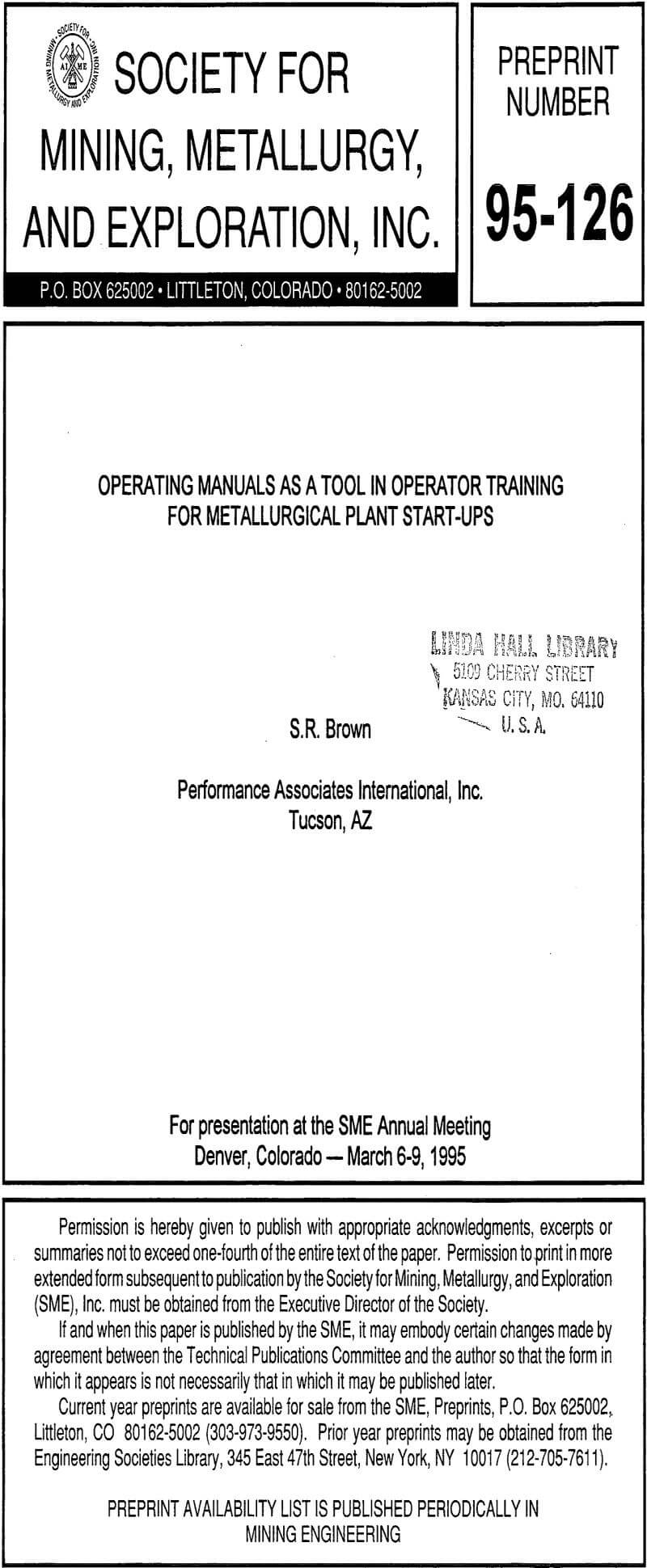Few people would dispute the necessity of transmitting literally thousands of pieces of information about the new plant to the operator. In fact, there is really only one way to actually do it We have found that writing a series of custom plant operating manuals, specifically designed for an education level of the average high school graduate, is the correct approach. These manuals are then used in a formal classroom training program, complete with graphic support, work books, and tests. The training must occur prior to mechanical completion. Ideally, the trained operators complete the class work and then assist with the final stages of preoperational testing. Only then are they ready to introduce feed and perform their normal operating functions.
The operating manuals that we have used over the years for this purpose have evolved based on our direct experience. We have found that the following contents work well, both for training, and as a continuing reference.
Operating Manuals Contents
Introduction: This section describes the purpose of the manuals and identifies those volumes in the set. It also illustrates the scope of the particular manual volume.
Use of the Manual: This section describes how pages are numbered and how to find information. It is important that the manual contents are well organized and it is easy for an operator to find the information he needs.
Safe Job Procedures: This section provides formal written procedures, including any special equipment required, to be followed by the operator when performing potentially hazardous job functions.
Process Design: This section provides a written description, complete with necessary schematic diagrams and illustrations, describing the process. It also includes brief principles of operation for all of the major process unit operations. For example, unit operations such as vacuum pumps, dryers, filters, etc. are described. It is essential that the operator is provided with the necessary information so he or she can describe the key operating principles. This section also provides an equipment list and color flowsheets. These flowsheets are simplified, having had the material balance information removed. Each process flow stream is produced with a different distinctive color.
Process Control: This section provides a table identifying each critical process variable, such as temperatures, flows, pressures, densities, etc. It also summarizes their target values, methods of control and their impact on the process. Following the process variable table, each control loop is described using text, a simple block diagram, and a simple loop diagram extracted from the piping and instrument diagram (P&ID). Each method of control such as automatic remote set point, automatic local set point, and manual are discussed, as applicable.
Interlocks: This section provides tables identifying all interlocks and permissives for each motor and affected instrument, along with cause-and-effect diagrams. The diagrams cover the same information as the tables and are used to complement the tables. The interlock tables and diagrams are organized by logical process system.
Alarms: This section illustrates each alarm in the process sorted by tag number. It is in a tabular format and includes the affected equipment, the fault, the potential causes, and the steps to take to remedy the alarm.
Operating Procedures: This section is divided into three sections: Start-Up, Shutdown, and Operator Tasks.
START-UP describes the detailed procedures necessary to start up the plant from a complete shutdown, from a standby shutdown, from a power failure, and from an emergency shutdown.
SHUTDOWN describes the procedures necessary for a complete shutdown, a standby shutdown, and an emergency shutdown. It also describes the effect of a power failure and any specific procedures the operator should perform.
OPERATOR TASKS describe additional procedures required to operate the plant. These procedures always include preoperational inspections necessary to set up the plant for start-up. They also include procedures necessary for the operator to perform his job function. They may also include any steps the operator must take to manually control key process variables. Typical operator tasks for various job functions are:
- Manual boiler blowdown.
- Measuring pH.
- Preparing a batch of flocculant.
- Preparing strip solution.
- Shift inspection.
An operator task procedure is important whenever consistency is critical.
Instrument List: This section provides a complete list of each instrument along with its service.
Operating Manuals Development
Writing each manual is a tedious and involved process. The following source material is needed:
- Flow diagrams.
- Piping and instrument diagrams.
- Equipment operating and maintenance instructions.
- Interlock logic diagrams.
- Motor control schematics.
- Design criteria.
- Equipment list.
- Instrument list.
This material is used to develop each of the sections previously described. Manual writers must be experienced in plant operation and should be good writers; this is often a difficult combination. Typically, several months must be dedicated to the manual wiring process. In many cases, engineering changes are still occurring as the manuals are being prepared; this adds to the complexity.
Once the manuals are completed, we suggest preparing an accompanying training module for each manual volume. The training module optimizes use of each of the manuals in a formal classroom instruction setting.
Training Module Contents
- Learning objectives and module outline
- Overhead transparencies
- Workbook
- Knowledge assessment test
- Qualification checklist

